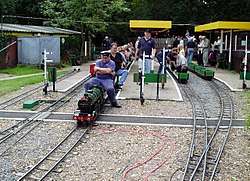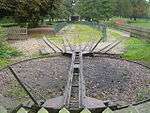Great Cockcrow Railway
 Trains and visitors at the Great Cockcrow Railway station in 2004 | |
| Locale | near Chertsey, Surrey, United Kingdom |
|---|---|
| Dates of operation | 1968– |
| Predecessor | Greywood Central Railway |
| Track gauge | 7 1⁄4 in (184 mm) |
| Website |
www |
The Great Cockcrow Railway is a 7 1⁄4 in (184 mm) gauge miniature railway located near Chertsey, Surrey, UK.[1] It is open on Sunday afternoons from May to October inclusive, plus Wednesday afternoons during August as well as May Bank Holiday.
History
This 7 1⁄4 in (184 mm) gauge railway originated in 1946 when John Samuel started construction in the garden of his house, 'Greywood', on the Burwood Park estate at Walton-on-Thames. With the help of a group of volunteers the Greywood Central Railway developed into one of the foremost of its type in the country until by 1962 a run of 3/4 mile was possible. From the first the line was properly signalled and ultimately worked to a timetable. Samuel's death in October 1962 threw the railway's future into doubt but the publisher, Ian Allan, purchased the line and, with the assistance of most of the GCR volunteers, a few of whom are still involved, moved it to its present site at Hardwick Lane, Chertsey. It reopened to the public on 14 September 1968 under the new name Great Cockcrow Railway, taken from Cockcrow Hill which rises on its south side.
Since that time the railway has been developed and enlarged, some two miles of track now being in the layout. Two different routes are offered to visitors, each of about 1.25 miles, a journey time of around twenty minutes.'Red Route' trains terminate at the country station, Cockcrow Hill, while 'Green Route' trains pass through that station to traverse a 350m-long loop beyond it. Return routes vary also. A named train, 'The Gladesman', runs each afternoon at 4.30. This consists of six or seven coaches double-headed and takes an extended route over the system.
The most recent innovation is a proper station building, completed in 2014 after several planning, financial and constructional delays. As expected it houses a Tea Room and toilets, including disabled facilities, as well as the booking office and staff accommodation. The railway is open to the public on Sundays from the beginning of May to the end of October between 1.30pm and 5.00 pm, (booking office closes 4.45pm.) as well as Wednesdays in August. A Gala Day with visiting engines is held in September, and on the last Saturday in October Halloween is celebrated with night-time operation.[2]
Stations
- Hardwick Central - the main terminus of the railway, where trains begin and finish their journeys. The railways sheds and station facilities are situated here, including Hardwick signal box, the ticket office and cafe.
- Everglades Junction - the main hub of the railway, from here Everglades signal box controls movements from Hardwick Central and Cockcrow Hill, routing trains as required.
- Jungle Halt - watch out for the residents of Jungle Halt, this is accessed by Red Route trains climbing The Spur.
- Green Lane - the railways furthest point, and where Green Route trains begin their journey back to Hardwick Central.
- Cockcrow Hill - originally the end of the line for "Branch" trains, this terminus was bypassed by the Millennium Line in the year 2000 and now trains have two different routes available to them. Red route trains still terminate at Cockcrow Hill where passengers can see the loco run round its train. Green Route trains bypass the terminus and circumnavigate the Millennium Line to send them back to Hardwick Central via Everglades Junction.
Signalling

Prototypical working with full track circuiting and accurate signalling remains the key to the railway's operation. The two termini are controlled by semaphores while the whole of the main line is equipped with colour-lights, 10 of these being automatic. The boxes at Hardwick Central and Everglades Junction are fitted with Westinghouse 'L' type frames with, respectively, twenty-three and thirty-one miniature levers. The former was once part of the 227-lever installation at Crewe South junction while the latter is the complete frame from South Croydon Junction. The country terminus, Cockcrow Hill, has a 16-lever full-size 'knee' frame manufactured by the Railway Signal Company, probably around 1930. It came from the Waterloo terminus of the Waterloo & City line.
Exactly as in full-size practice trains are offered and accepted between signal boxes by the use of Block instruments. Hardwick is configured as a Midland box, Everglades is Southern. Because of the complication of the area it controls, and there may be as many as six trains on the track diagram at once, Everglades Junction box is also equipped with a train describer to assist the signalmen, usually two on duty together, in keeping track of movements. The train describer is also of great use in logging locomotive activity over the course of a season, and calculating average route miles.
The signalling system is all-electric, including the interlocking, semaphores being worked by solenoids sealed for outdoor use. All signals are weighted to return to 'danger' when the train has passed into the next track-circuit section. Points have a mechanism powered by the very reliable Ford Escort windscreen wiper motor that moves the blades and then locks and detects them, no detection means no signal! The few sprung points in the facing direction are also electrically detected with micro-switches to ensure closure after a train has passed through in the trailing direction.
Locomotives
There are presently 35 steam engines and 8 instant start locomotives in the stud, all owned by individual members of the operating team. Six or seven can usually be seen on operating days, with several other types resting, or under construction by members.
Most of the steam locomotives are based on British mainline prototypes built to 1/8 scale. All four pre-Nationalisation companies are represented and locos from both pre-Grouping and BR 'Standard' eras are present, as well as some freelance types. The oldest, a North Eastern Railway class 'R1' (LNER D19) 4-4-0 was built in 1913 and is still in working order. The smallest is a Bridget type 0-4-2T while the largest are the 4-6-2 'Pacifics',the oldest being a freelance version built by Louis Shaw in 1927 and given the name 'Eureka' by Sir John Samuel in 1947 as he had found, in his opinion, the ideal engine for his railway. Other Pacifics represent prototypes from the LMS, LNER and Southern companies, as well as British Railways. Engines of 2-6-0 and 4-6-0 wheel arrangement feature as do 'Atlantics' from both the GNR and LBSCR alongside 0-8-0, 2-8-0 and 2-10-0 goods engines. A comprehensive list follows.
Trains
Rolling stock consists of thirty-five 4-seater 'sit-in' carriages and a set of 4 coaches are articulated into twins. Trains hauled by the smaller engines are generally made up of three carriages to accommodate twelve passengers: the more powerful locos will as a rule take four, carrying up to sixteen. The all-up weight of a 3-car train - without the engine - is estimated on average to be about 11⁄4 tons or 1270 kg. 'The Gladesman' is double-headed and is made up of six carriages depending on demand. A varied collection of freight and engineering stock may also be seen.
List of locomotives
Southern Railway
- 'T9' class 4-4-0 no 730, 2014, Olive Green
- 'T9' class 4-4-0 no 30285, 2015, BR 'late emblem' lined black.
- 'T9' class 4-4-0 no 117, 2015, SR unlined black.
- 'H16' class 4-6-2T no 517, 2015 Maunsell Green.
- 'LN' class 4-6-0 no 850, 'Lord Nelson', 1985, Lined Brunswick Green.
- 'S15' class 4-6-0 no 837, 1947, GCR (Cockcrow) unlined black.
- Ex-LBSCR 'H2' class 4-4-2 no 2422, 'North Foreland', 1981, Maunsell Green.
- 'U'/Rebuilt 'River' class 2-6-0 no 1803, 'River Itchen', 1936, Maunsell Green.
- 'Q' class 0-6-0 no 30541, 2000, BR unlined Black.
- 'Q' class 0-6-0 no 30542, 2000, BR unlined Black.
London & North Eastern Railway
- 'A3' class 4-6-2 no 2744, 'Grand Parade', 1990, Apple Green:
- ex-GNR 'C1' class 4-4-2 no 1442, 1988, GNR Grass Green:
- ex-NER 'R1' class 4-4-0 no 1239, 1913, GCR (Cockcrow) Pea Green:
- 'K3' class 2-6-0 no 1935, 1975, Apple Green:
- 'K5' class 2-6-0 no 206, 1956 Wartime lined Black:
- ex-NER 'T2' class 0-8-0 no 1249, 'Hecate' 1986 NER lined Black:
- Louis Shaw-type Freelance 4-6-2 no 1947, 'Eureka', 1927, Greywood Central Railway lined green livery
- Louis Shaw-type Freelance 4-4-2 no 67345 "R D Lawrie", 1953, lined Malachite green.
Great Western Railway
- '7900' 'Modified Hall' class 4-6-0 no 7915, 'Mere Hall', 1952, BR Brunswick Green:
- '4700' class 2-8-0 no 4704, 2015, Brunswick Green.
- '1400' class 0-4-2T no 1401, 1980, BR unlined Black.
London, Midland & Scottish Railway
- '8P' class 4-6-2 no 46245, 'City of London', 1950, lined BR Red:
- '6P' class 4-6-0 no 6115, 'Scots Guardsman', 1989, LMS lined Red:
- '6P' class 4-6-0 no 6100, 'Royal Scot', 1981, LMS lined Red:
- '5MT' class 4-6-0 no 5000, 'Sister Dora', 1981, LMS unlined Black:
- '5MT' class 4-6-0 no 5241, (Building date unknown) LMS lined black
- '5MT' class 4-6-0 no 45145, 1991, BR '1948' Black:
- '5MT' class 4-6-0 no 45157, 'Glasgow Highlander', 1997, 'Late' BR lined Black:
- '5MT' class 4-6-0 no 45440, 2004, 'Early' BR lined Black:
- '8F' class 2-8-0 no 8374, 1993, unlined LMS Black:
British Railways
- '7MT' class 4-6-2 no 70054, 'Dornoch Firth', 2014, BR Brunswick Green:
- ex-'WD' class 2-10-0 no 73755, 'Longmoor', 1952, War Department unlined grey:
Other steam locos
- Freelance Bridget 0-4-2T 'Alison', 2006, unlined Holly Green:
- Holmside-type 0-6-0ST 'Wensleydale' NCB no 684, 2012, lined GER blue
- Freelance/Midge 0-4-0 tender loco 'Lulubelle' no 1, build date unknown, GCR (Cockcrow) lined Brunswick Green
- Midge GWR 0-4-0T, build date unknown, to be restored in Greywood Central livery (currently unpainted!)
Non-steam
- LMS jackshaft 350 hp 0-6-0 battery-electric shunter 'Winifred' no 11, 1958, GCR (Cockcrow) Black: (ex petrol mechanical).
- BR 350 hp Class 09 shunter 'Wilfred' battery electric 0-6-0, BR Green
- GER C53 Tram Engine 4wBE "Livvy" built 2007, rebuilt for service 2018. GCR (Cockcrow) unlined black with brown body.
- 'Dock Authority' 4wBE shunter 'Eddie', 2015, unlined Black
- BR 204 hp Class 04 6wBE shunter, 2015, BR Blue.
- BR Mardyke 'Deltic' 6w-6wPH no 55 007, 'Pinza', 1978, BR Blue.
- BR class 52 Western 6w-6wBE, 2016, BR Maroon.
- BR class 52 Western 6w-6WBE, 2016, BR Green.
- BR class 31 Brush Type 2 6w-6wBE, 2005, BR Green.
- BR class 14 shunter 0-6-0BE, 2017, BR Green.
- "The Flying Armchair", 4wBE, 2018, works shunter
References
- ↑ British Pathé (13 April 2013). Greywood Miniature Railway (1956). YouTube.
- ↑ "History". Great Cockcrow Railway.
External links
| Wikimedia Commons has media related to Great Cockcrow Railway. |
Coordinates: 51°23′06″N 0°31′23″W / 51.3849628°N 0.5230629°W
